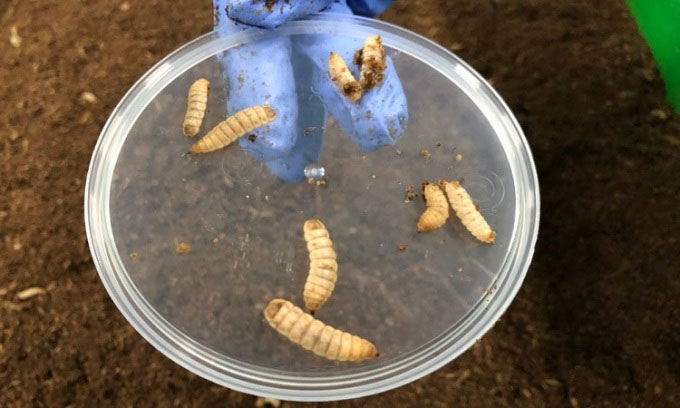Protix specializes in producing black soldier fly larvae, known for their short life cycle and high egg production, used as animal feed.
The insect farm of Protix is located in the town of Bergen op Zoom in the southern Netherlands and has been operational since 2019. This 15,000 m² warehouse is the largest black soldier fly farm in the world. The demand for edible insects and similar insect farming facilities is steadily increasing.

Black soldier fly larvae raised on the farm. (Photo: Emilie Filou)
Currently, approximately 80% of Protix’s products are used as pet food, while the remainder is used for aquaculture and poultry farming. This is expected to change soon as farmers raising fish, poultry, and pigs seek alternative protein sources to fishmeal and soy. The European Union approved the use of insect protein in poultry and pig farming last year, and also allowed the use of crickets, mealworms, and migratory locusts as food for humans.
Protix is preparing to announce 10 new locations as it expands in Europe and North America. The company’s facilities are the result of a decade of research and development, demonstrating that insect protein can improve the environmental impact of feed. The current plant has been producing 15,000 tons of live larvae annually for the past two years, equivalent to 10,000 tons of protein per hectare per year. In comparison, soybeans only provide about one ton of protein per hectare per year.
Protix has developed technology for breeding flies, which took 10 years to perfect. The first thing you notice upon entering the facility is the smell of insect feed, reminiscent of the scent from a hamster cage. The factory is divided into various areas corresponding to different steps of the process, but the central area is a vertical farm. This is where the larvae live in loosely stacked bins reaching nearly 4 meters in height and 16 meters deep. The temperature is maintained at -30 degrees Celsius. The farm has three such storage areas arranged around a central conveyor system that both feeds and harvests the insects. Technicians control each step of the process via a central control panel. Everything is custom-designed, from the shape of the bins to the proprietary software.
The larvae feed on by-products from the food and beverage industry, such as potato waste from a factory in France or spent grains. The feed ingredients are delivered daily and stored in containers at the back of the factory. They are then mixed and processed into a special ground powder using mixers. The larvae are fed every two days. An automatic crane pulls each row of bins out. The bins move around the conveyor system to dispense food and are then returned to the vertical storage area.
The larvae can be harvested after 6 to 8 days. Only 1% of the larvae are kept to develop into adult flies for breeding in a special chamber. For harvesting, the bins are lifted onto the central conveyor system and dumped onto a giant sieve, where the larvae are separated from any remaining feed before being washed. The larvae are then transferred to an adjacent room for processing. Protix’s main products are protein feed and a type of oil extracted through centrifugation.


















































